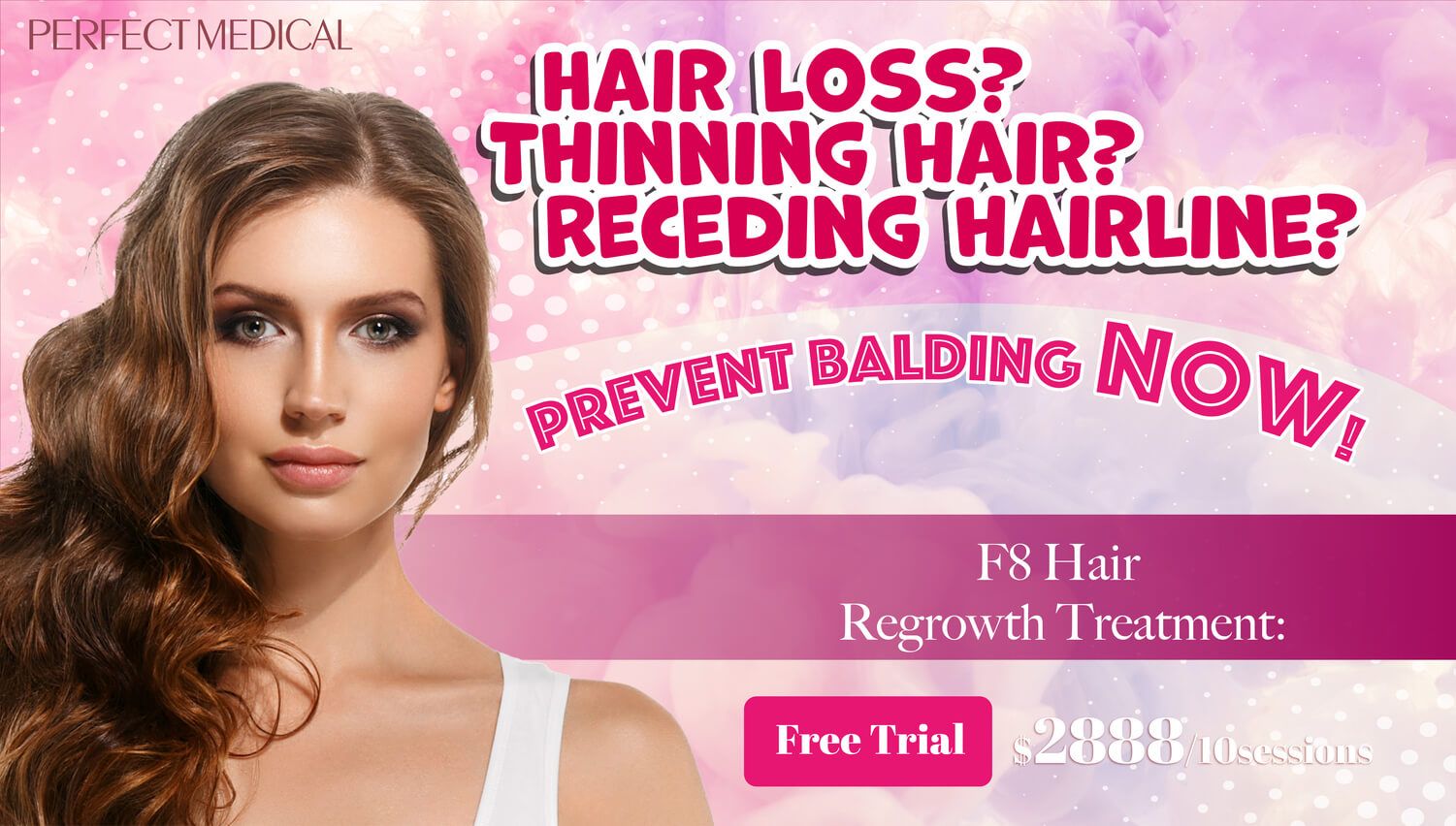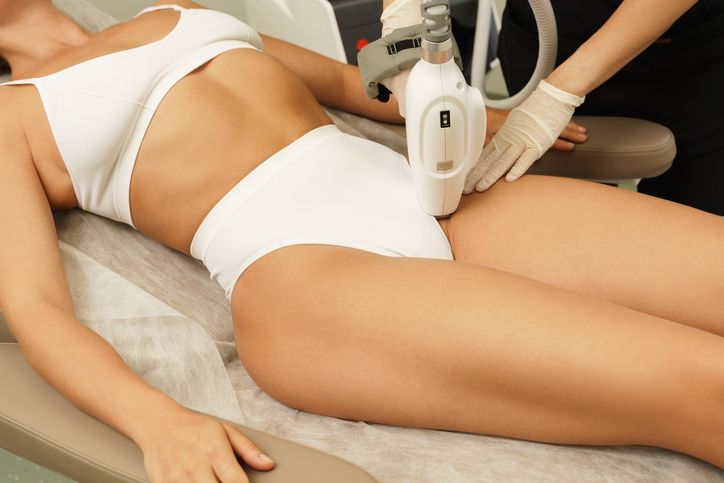- Home
- Trend
- Weight Loss Strategies
- Acne Tips
- Hair Health Information
- Blemish Removal Tips
- Acne Scar Removal Tips
- Muscle Building Techniques
- Intimate Care Tips
- Postpartum Intimate Care
- Eye Bags Wiki
- Tips for Face Slimming
- Secret of Permanent Hair Removal
- Breast Enlargement Tips
- Cure to Snoring
- Marionette Lines
- Skin-Tightening Secrets

免費體驗
F8 Hair Regrowth Treatment
1 Minute Self-Registration
Date should not be before minimal date
Hair loss is a common condition that affects many people at some point in their lives. It can be caused by various factors, such as genetics, hormones, stress, illness, medication, or ageing. Some types of hair loss are temporary and can be reversed with proper treatment, while others are permanent and may require hair transplantation or other cosmetic procedures.
1
The Symptoms of Sudden Hair Loss

These are some of the ways to prevent or reduce hair loss at middle age. However, remember that some degree of hair loss is normal as you age and that everyone has different hair types and conditions. Some of the symptoms that may indicate that you have hair loss are:
Thinning of hair on the scalp, especially on the crown or temples
If you notice that your hair is becoming visibly thinner in these areas, it could be a sign of hair loss. This is commonly associated with male and female pattern baldness.
Receding hairline or bald patches
A receding hairline, where the hairline gradually moves backward, or the presence of bald patches on the scalp, may indicate hair loss is occurring.
Excessive shedding of hair, especially after washing, brushing, or styling
While it's normal to shed some hair daily, if you observe an increased amount of hair shedding during these activities, it could be a sign of hair loss.
Reduced hair volume or density
If your once full and voluminous hair seems to be losing its density, it might be a sign of hair thinning or loss.
Changes in the texture or quality of hair, such as dryness, brittleness, or breakage
Hair affected by hair loss may become dry, brittle, and more prone to breakage, making it difficult to manage.
Scalp irritation, itching, or inflammation
Irritation, itching, or inflammation of the scalp might be linked to certain scalp conditions that contribute to hair loss.
If you experience any of these symptoms, it's essential to consult a healthcare professional or a dermatologist to determine the underlying cause of your hair loss and explore suitable treatment options. Early intervention can make a difference in managing hair loss and promoting hair health as you age.
2
Treat Thinning Hair With Baby Steps: Daily Habits You Should Do When Hair Loss Occurs

Hair loss is a common concern for many people, especially in middle age. There are many possible causes of hair loss, such as genetics, stress, medication, or health conditions. However, there are also some ways to prevent or slow down hair loss by taking care of your hair and scalp. Here are some tips to help you keep your hair healthy and strong:
Eat a balanced diet that is rich in protein, vitamins, and minerals.
Protein is the main component of hair, so eating foods like eggs, nuts, beans, fish, and lean meats can help your hair grow and stay healthy. Some vitamins and minerals that are important for hair health are vitamin A, vitamin B, vitamin C, vitamin D, iron, selenium, and zinc. You can get these nutrients from foods like fruits, vegetables, whole grains, dairy products, and fortified cereals. A Mediterranean diet that includes raw vegetables and fresh herbs may also reduce the risk of hair loss.
Avoid hairstyles that pull on your hair or cause tension on your scalp.
Hairstyles like cornrows, tight braids, ponytails, or buns can damage your hair follicles and lead to hair loss over time. Instead, opt for loose or low hairstyles that do not put stress on your hair or scalp. You can also use gentle hair accessories like clips or bands that do not pull or snag your hair.
Avoid high-heat styling tools or chemical treatments that can damage your hair.
Hair dryers, curling irons, straighteners, bleaches, dyes, perms, and relaxers can all weaken your hair and make it more prone to breakage and loss. If you use heat styling tools, use the lowest setting possible and apply a heat protectant product before styling. If you want to color or treat your hair, limit the frequency and use mild products that do not contain harsh chemicals.
Wash your hair less frequently and use a mild shampoo and conditioner.
Washing your hair too often can strip away the natural oils that protect your hair and scalp from damage. It can also dry out your hair and make it more brittle and frizzy. Try to wash your hair only two or three times a week with a gentle shampoo that suits your hair type and condition. Use a conditioner after shampooing to moisturise your hair and prevent tangles.
Check your medications with your doctor if you suspect they are causing hair loss.
Some medications can have side effects that affect your hair growth or cause hair loss. These include drugs for blood pressure, cholesterol, diabetes, arthritis, depression, heart problems, and cancer. If you notice increased hair loss after starting a new medication or changing the dose of an existing one, talk to your doctor about possible alternatives or adjustments.
Use over-the-counter products or treatments that may help with hair loss.
There are some products or treatments that you can buy without a prescription that may help prevent or treat hair loss. These include minoxidil (Rogaine), which is a topical solution that you apply to your scalp twice a day to stimulate hair growth; biotin (vitamin B7), which is a supplement that you take orally to improve your hair quality and strength; and low-level laser therapy (LLLT), which is a device that emits red light to stimulate blood flow and cell activity in your scalp. However, before using any of these products or treatments, consult with your doctor about their safety and effectiveness for your specific case.
Maintain good hygiene and care for your hair and scalp.
Keeping your hair and scalp clean and healthy can prevent infections, inflammation, or irritation that can cause or worsen hair loss. Brush your hair gently with a wide-toothed comb or a soft-bristled brush to avoid pulling or breaking your hair. Massage your scalp with your fingertips or a scalp massager to improve blood circulation and relax your muscles. Avoid scratching or picking at your scalp if you have dandruff or other scalp conditions. Treat any underlying scalp issues with appropriate products or medications.
- Are Hair Vitamins the Best Hair Growth Supplements for Your Thinning Hair?
- How To Stop Hair Fall Immediately? There Are 10 Things You Should Do To Control Hair Fall
- Hair Loss SOS: Recognising the Signs of Hair Receding
- Hair Loss and Stress: Everything You Need to Know About Stress-Induced Balding and How to Treat It
3
Temporary Hair Loss, Patchy Hair Loss...What's the Difference?

There are many types of hair loss, also known as alopecia, that can affect different areas of the scalp or other parts of the body. Some of the most common forms of hair loss are:
Androgenetic alopecia
This is a genetic condition that causes hair to thin gradually over time. It can affect both men and women, but it is more common and noticeable in men. It usually starts with a receding hairline and progresses to baldness on the top and front of the head.
Alopecia areata
This is an autoimmune disorder that causes patches of hair to fall out, leaving smooth, round bald spots on the scalp or other areas. It can affect anyone, but it often occurs in children and young adults. It may be triggered by stress, illness, or other factors. The hair may grow back in some cases, but it may also fall out again or become permanent.
Telogen effluvium
This is a temporary condition that occurs when the hair follicles enter a resting phase and stop producing new hair. It can be caused by hormonal changes, medication, illness, surgery, or other stressors. The hair usually sheds in large amounts, especially when washing or brushing. It may take several months for the hair to return to normal growth.
Traction alopecia
This is a type of hair loss that occurs when the hair is pulled too tightly for a long time, such as by braiding, ponytails, cornrows, or extensions. It can damage the hair follicles and cause them to stop growing hair. It can affect any part of the scalp where the hair is pulled, but it is more common on the edges and temples. It may be reversible if the pulling is stopped early enough, but it may also lead to permanent scarring and baldness.
Scarring alopecia
This is a rare type of hair loss that occurs when the hair follicles are destroyed by inflammation, infection, injury, or disease. It can affect any part of the scalp or body where hair grows, but it is more common on the scalp. It causes permanent baldness and scarring on the affected areas. Some examples of conditions that can cause scarring alopecia are lichen planopilaris, discoid lupus erythematosus, folliculitis decalvans, and frontal fibrosing alopecia.
4
Possible Causes of Your Hair Loss

Many people experience thinning hair in middle age, which can affect their self-esteem and confidence. Thinning hair can have various causes, such as genetics, hormonal changes, stress, illness, medication, or nutritional deficiencies. In this article, we will explain some of the common factors that contribute to thinning hair in middle age and how to cope with them.
Genetics
Some people inherit a tendency to lose hair as they age, especially men who may develop male pattern baldness. This is caused by a hormone called dihydrotestosterone (DHT), which shrinks the hair follicles and makes them produce thinner and shorter hairs. There is no cure for genetic hair loss, but some treatments can slow down or prevent further thinning, such as minoxidil, finasteride, or hair transplantation.
Hormonal changes
Women may experience thinning hair during menopause, when the levels of estrogen and progesterone decline. These hormones help maintain the growth and thickness of the hair, so their decrease can lead to hair loss. Hormonal changes can also affect the thyroid gland, which regulates the metabolism and the growth of the hair.
Hypothyroidism (low thyroid function) or hyperthyroidism (high thyroid function) can cause thinning hair, along with other symptoms such as fatigue, weight gain or loss, mood swings, or dry skin. Hormonal imbalances can be diagnosed by a blood test and treated with medication or hormone replacement therapy.
Stress
Stress can trigger a type of hair loss called telogen effluvium, which occurs when a large number of hairs enter the resting phase and fall out after a few months. This can happen after a traumatic event, such as a divorce, death of a loved one, surgery, or infection. Stress can also affect the immune system and cause inflammation, which can damage the hair follicles and lead to alopecia areata, a condition that causes patches of baldness on the scalp or other parts of the body. To reduce stress and its effects on the hair, it is important to practise relaxation techniques, such as meditation, yoga, breathing exercises, or counselling.
Illness
Some diseases can cause thinning hair in middle age, such as diabetes, lupus, anaemia, or autoimmune disorders. These conditions can interfere with the blood supply to the scalp, the production of red blood cells, or the function of the immune system. They can also cause symptoms such as fever, pain, fatigue, or skin rashes. If you suspect you have an underlying illness that is affecting your hair growth, you should consult your doctor for diagnosis and treatment.
Medication
Some medications can have side effects that include thinning hair in middle age. These include drugs for high blood pressure, cholesterol, arthritis, depression, cancer, or birth control. The hair loss usually stops when the medication is discontinued or changed to a different one. However, you should not stop taking your prescribed medication without consulting your doctor first.
Nutritional deficiencies
A lack of certain nutrients can affect the health and growth of the hair in middle age. These include protein, iron, zinc, biotin, vitamin B12, vitamin D, and omega-3 fatty acids. These nutrients are essential for the production of keratin, the protein that makes up the hair shafts; haemoglobin, the protein that carries oxygen to the scalp; collagen, the protein that supports the skin and hair follicles; and sebum, the oil that moisturises the scalp and hair. To prevent or correct nutritional deficiencies, you should eat a balanced diet that includes lean meats, eggs, fish, nuts, seeds, fruits, vegetables, and whole grains.

免費體驗
F8 Hair Regrowth Treatment
1 Minute Self-Registration
Date should not be before minimal date
5
Conquer Hair Loss With The Right Hair Loss Treatment: F8 Hair Regrowth Treatment

In the rapidly evolving global beauty sector, scientists have developed a game-changing method of treating hair loss. Low-level laser therapy can be quite effective at encouraging healthy hair growth when combined with additional therapies like topical medications or nutritional supplements. The best results are usually achieved following a series of treatments spread out over time, as this allows progressive stimulation to build up over time; this is when the F8 Hair Regrowth Treatment at Perfect Medical comes in handy.
Perfect Medical's F8 Hair Regrowth Treatment stimulates hair growth by increasing blood flow to the follicles with the aid of low-level laser radiation. This is a non-surgical approach to reversing hair loss by strengthening hair follicles, hair papilla, and scalp blood vessels. A hair growth serum is used as a finishing touch after the laser treatment. This high-quality medical essence is ideal for thoroughly cleaning the scalp and releasing any clogged hair follicles.
The experts at F8 will examine your scalp with 200x magnification gear to determine the root of your hair loss before beginning the F8 Hair Regrowth Treatment. Once the root cause of hair loss has been identified, the professionals will determine the extent of the problem and pinpoint the areas of the scalp where hair loss is most prevalent. Most importantly, perfect Medical's F8 Hair Regrowth Treatment doesn't take more than an hour to complete. It's non-surgical so there's no need to spend the night in the hospital.
Enhanced hair follicle growth, increased hair density, and a healthier scalp are all benefits of increased blood flow, which is made possible by the energy emitted. This nurturing treatment can also promote the rapid development of healthy hair follicles with deep, sturdy roots. Book an appointment today to cure your thinning hair worries!

免費體驗
F8 Hair Regrowth Treatment
1 Minute Self-Registration
Date should not be before minimal date
FAQ

1. What causes female pattern baldness?
Female pattern baldness is usually hereditary, meaning it runs in families. It is influenced by genes that affect the hair growth cycle and the sensitivity of the hair follicles to male hormones called androgens. Female pattern baldness may also be triggered or worsened by hormonal changes, such as menopause, or by certain medical conditions, such as polycystic ovary syndrome (PCOS).
2. How is female pattern baldness treated?
Female pattern baldness can be treated with medications, such as minoxidil or finasteride, that stimulate hair growth or block the effects of androgens. Other options include red light therapy, which may increase blood flow and oxygen to the scalp, or hair transplantation, which involves moving healthy hair follicles from one part of the scalp to another. Some people may also choose to use cosmetic products, such as wigs, hair extensions, or scalp micro pigmentation, to cover up the areas of hair loss.
3. How low-level laser therapy helps to slow down permanent hair loss?
LLLT is believed to enhance blood circulation in the scalp. The laser energy helps to dilate blood vessels, promoting better nutrient and oxygen delivery to hair follicles. This improved blood flow nourishes the hair follicles and can stimulate hair growth.
4. What hair fall rate is abnormal?
The rate at which people lose their hair can vary a lot from person to person, and what is called abnormal can depend on the person's specific situation. As part of the hair's natural growth cycle, most people lose between 50 and 100 hairs per day. This is a normal part of the hair growth cycle, and new hairs will grow in to replace the ones that have fallen out.
5.Can scalp massage help hair growth?
Yes, massaging the head can help make hair grow faster. Even though it may not be enough to stop serious hair loss on its own, massaging the scalp regularly can make it healthier and may help hair grow.









